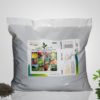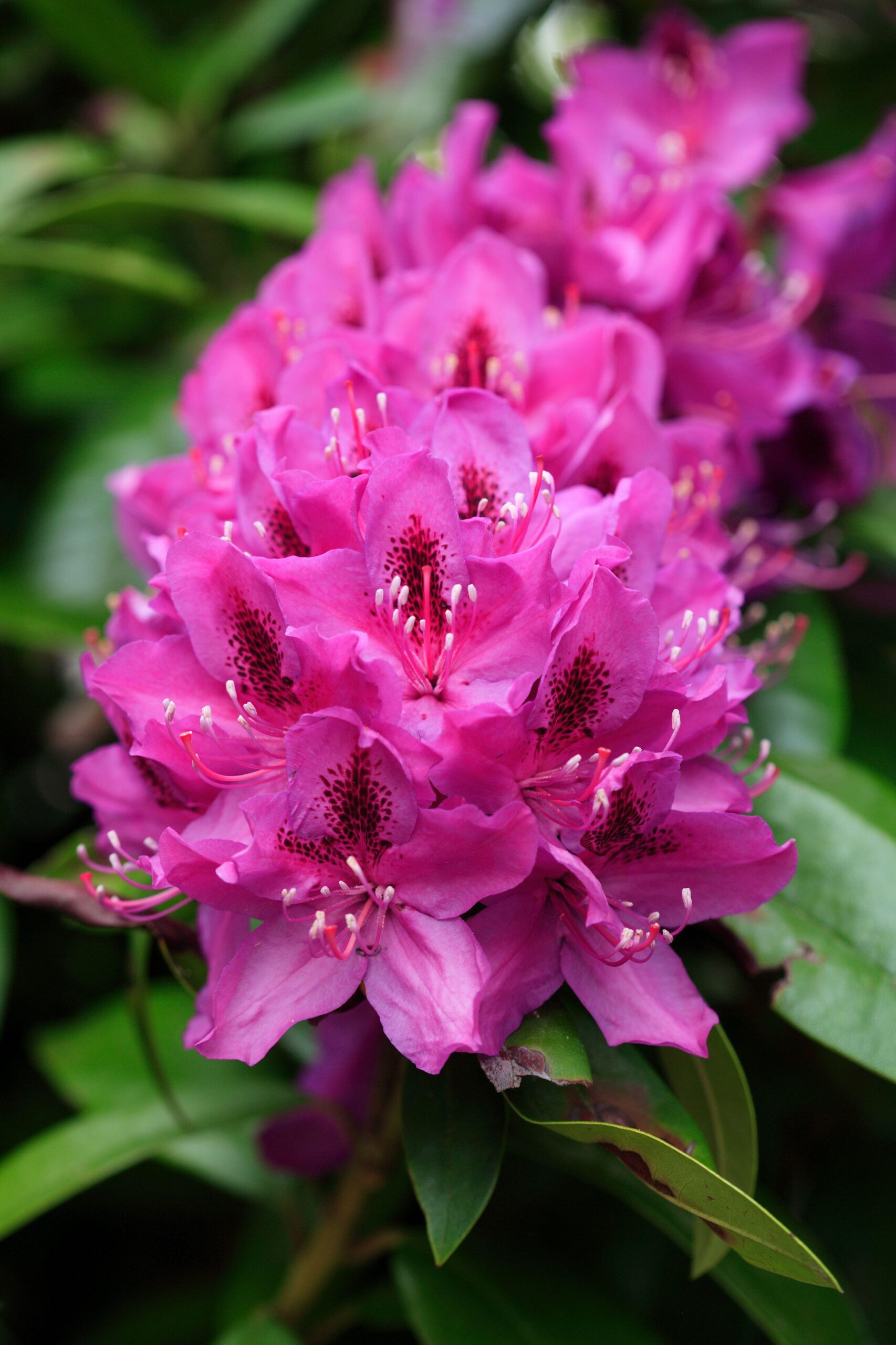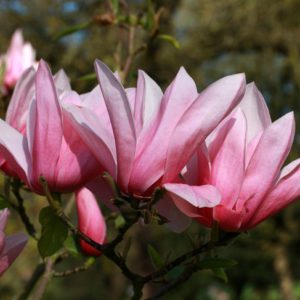Rhododendron ‘Anah Kruschke’
€22.00
Frequently Bought Together


Description
Quick Facts
- Common Name: Anah Kruschke Rhododendron
- Botanical Name: Rhododendron ‘Anah Kruschke’
- Plant Type: Evergreen shrub
- Mature Height: 1.5-2m
- Mature Spread: 1.5-2m
- Flowering Period: May to June
- Flower Colour: Deep reddish-purple to lavender-purple with darker markings
- Foliage: Glossy dark green evergreen leaves
- Hardiness: RHS H5 (hardy throughout UK and Ireland)
- Soil Requirements: Moist, well-drained, acidic soil (ericaceous)
- Aspect: Partial shade to full shade
- Maintenance: Low
Description
Experience the breathtaking beauty of Rhododendron ‘Anah Kruschke’, one of the most spectacular and richly coloured evergreen rhododendrons for gardens, where abundant deep reddish-purple to lavender-purple flowers with darker markings, glossy dark green evergreen foliage, and compact vigorous habit combine to create stunning displays of extraordinary colour and architectural presence that bring weeks of late spring blooms and year-round structure with remarkable flower abundance making this perfect for adding dramatic colour, reliable evergreen presence, and classic rhododendron elegance to shaded borders, woodland gardens, and acidic borders. This exceptional hybrid cultivar offers remarkable qualities—spectacular abundant deep reddish-purple to lavender-purple flowers with distinctive darker purple markings creating rich jewel-toned displays, large showy flower trusses measuring 12-15cm across packed with numerous individual blooms creating substantial visual impact, compact rounded habit reaching 1.5-2m tall making it ideal for smaller gardens and mixed borders where larger rhododendrons would overwhelm, glossy dark green evergreen foliage creating year-round structure and polished backdrop, and outstanding hardiness and shade tolerance thriving in woodland conditions and shaded positions throughout UK and Ireland with remarkable vigour, making this one of the most rewarding and reliable choices for adding late spring flowering colour, dramatic purple blooms, and evergreen structure to shade gardens and acidic borders.
Throughout the seasons, this captivating shrub displays spectacular late spring interest—in late spring to early summer (May-June), the plant becomes covered in abundant deep reddish-purple to lavender-purple flowers creating extraordinary displays. The flowers are arranged in large dome-shaped trusses (rounded clusters) measuring 12-15cm across and containing 12-18 individual flowers per truss creating substantial presence. Each individual flower is funnel-shaped to bell-shaped, measuring 5-7cm across with five rounded petal lobes creating classic rhododendron form. The flower colour is deep reddish-purple to rich lavender-purple to violet-purple creating intense jewel-toned displays—one of the most richly coloured purple rhododendrons available. The upper petal (dorsal lobe) features distinctive darker purple to nearly black markings (flare pattern) and subtle spotting creating depth and visual interest. The flowers open from darker purple buds creating beautiful colour progression. The flowers are produced prolifically covering the plant in purple creating spectacular impact—mature specimens can produce dozens to hundreds of trusses simultaneously. The flowers have light sweet fragrance attracting bees and other pollinators. The flowering display typically lasts 3-4 weeks in late spring. The foliage is attractive year-round—large elliptical to oblong leaves measuring 10-15cm long and 4-6cm wide with smooth edges and slightly rolled margins creating refined appearance. The leaves are glossy dark green to deep green on upper surfaces with high gloss creating polished lustrous effect. The undersides are paler green. The foliage is densely arranged in whorls at branch tips creating substantial coverage. The leaves remain evergreen year-round providing constant structure—in winter, the glossy dark green foliage remains attractive providing reliable presence when many gardens are dormant. The growth habit is compact, dense, and naturally rounded—multiple stems arise from base creating bushy mounded form. Mature plants typically reach 1.5-2m tall and equally wide, forming substantial rounded specimens more compact than many rhododendrons. Growth is moderate, adding 15-25cm annually. The overall effect is dramatic, elegant, and abundantly colourful—like having jewel-toned purple domes creating spectacular late spring displays with glossy evergreen presence year-round.
Rhododendron ‘Anah Kruschke’ is a hybrid rhododendron developed in the United States in the 1940s, bred by crossing selected parent plants to achieve exceptional flower colour, compact habit, and cold hardiness. The cultivar is named after Anah Kruschke, honouring the breeder’s family. The genus name Rhododendron comes from the Greek ‘rhodon’ (rose) and ‘dendron’ (tree), meaning “rose tree.” This cultivar was specifically selected for exceptional deep reddish-purple flower colour with distinctive darker markings creating rich displays, large showy flower trusses providing substantial impact, compact rounded habit ideal for smaller gardens, abundant flowering with numerous trusses produced simultaneously, and excellent cold hardiness and garden performance. Hardy to RHS H5, this exceptionally robust rhododendron thrives throughout UK and Ireland with complete reliability, tolerating cold winters (to -15°C) and recovering vigorously in spring. Moderate growth rate, forming substantial flowering specimens within 5-7 years. Particularly valuable for spectacular deep reddish-purple flowers with darker markings creating jewel-toned displays, abundant large flower trusses providing 3-4 weeks of late spring colour, compact rounded habit ideal for smaller gardens and mixed borders, glossy dark green evergreen foliage creating year-round structure, and outstanding hardiness and shade tolerance thriving in woodland conditions. The rich purple colour and compact habit make this outstanding for dramatic spring displays in shade gardens. IMPORTANT NOTE: Rhododendron leaves and flowers are toxic if ingested—keep away from children and pets.
Create stunning compositions by planting in shaded borders and woodland gardens where the shade tolerance and spectacular purple flowers create dramatic focal points beneath trees and in dappled shade, using in acidic borders combined with other ericaceous plants (azaleas, pieris, camellias) creating layered seasonal interest, or positioning as specimen shrubs in mixed borders where the compact habit and late spring blooms provide seasonal drama. Exceptional in foundation plantings near house entrances where the evergreen structure and spring colour provide year-round presence, in Japanese-inspired gardens where the elegant form and rich colour reflect traditional aesthetics, or in spring gardens where the purple flowers combine with other late spring bloomers. Works beautifully combined with other rhododendrons and azaleas (pink, white, or red varieties) for extended colour combinations and harmonious displays, combined with complementary foliage plants—hostas (blue, gold, or variegated varieties) for bold textural contrast, ferns (Athyrium, Dryopteris, Polystichum) for delicate woodland character, or heathers and heaths (Calluna, Erica) for year-round colour. Also magnificent combined with spring-flowering perennials (primulas, meconopsis, trilliums) that bloom simultaneously, spring bulbs (bluebells, wood anemones, erythroniums) for layered spring interest, or ornamental grasses (Hakonechloa, Carex, Luzula) for textural contrast and movement. Perfect for adding late spring flowering colour, dramatic purple blooms, and evergreen structure to shade gardens, woodland plantings, and acidic borders. Excellent for attracting pollinators and creating spectacular spring focal points.
Caragh Garden Notebook
Planting: Space plants 1.5-2m apart for individual specimens, or 1.2-1.5m apart for informal groupings that will merge creating continuous displays. Plant container-grown specimens in spring (March-May) or autumn (September-October) for best establishment. Choose position in partial shade to full shade—thrives in dappled shade under deciduous trees (particularly oak, birch, or pine), on north or east-facing borders, or in areas receiving morning sun and afternoon shade. Avoid full sun which can scorch foliage and fade flowers. Shelter from cold drying winds and late frosts which can damage flower buds and blooms—position in protected woodland conditions or sheltered borders. CRITICAL: Requires acidic soil (pH 4.5-6.0)—will not thrive in neutral or alkaline soils. Test soil pH before planting. Dig generous planting hole twice width of root ball but same depth—rhododendrons have shallow root systems and should NOT be planted deeply. Use ericaceous (acid) compost to backfill—do NOT use ordinary garden soil or compost if your soil is not naturally acidic. Plant at same depth as in container or slightly higher (2-3cm above soil level), ensuring root ball is NOT buried—the crown should be visible. Backfill with ericaceous compost, firming gently. Water thoroughly with rainwater (not tap water in hard water areas as this is alkaline). Apply generous 8-10cm mulch of acidic organic matter (composted bark, pine needles, leaf mould from oak or conifer) around base, keeping mulch clear of stem (5cm gap). Water regularly during first growing season using rainwater where possible. Position where the purple flowers and evergreen foliage can be appreciated. WARNING: All parts toxic if ingested—plant away from areas frequented by children and pets.
Soil Preparation: ESSENTIAL: Requires acidic soil (pH 4.5-6.0)—this is non-negotiable! Test soil pH before planting using simple soil test kit. If your soil is neutral or alkaline, either create raised beds filled with ericaceous compost or grow in large containers with ericaceous compost—attempting to grow in unsuitable soil will result in failure with yellowing leaves (chlorosis) and poor growth. Prefers moist, well-drained, humus-rich acidic soil for best growth and flowering. Requires well-drained soil—avoid waterlogged conditions which cause root rot, though rhododendrons appreciate consistent moisture particularly during flowering and bud formation. Thrives in woodland soils rich in organic matter and leaf mould. Rhododendrons have shallow fibrous root systems that spread near the surface—avoid deep cultivation around plants. If your soil is naturally acidic, improve by incorporating generous amounts of acidic organic matter (composted bark, pine needles, leaf mould, ericaceous compost, well-rotted pine or conifer sawdust) to improve moisture retention, fertility, and replicate natural woodland conditions. Mulch generously annually in spring with 8-10cm layer of acidic organic matter around base to maintain acidity, conserve moisture, suppress weeds, keep roots cool, and provide nutrients. IMPORTANT: Use rainwater for watering in hard water areas—tap water contains lime which raises soil pH making it unsuitable. Best growth and flowering occur in partial shade with moist, well-drained, humus-rich acidic soil—these conditions produce the most abundant deep purple flowers and healthiest growth.
Container Growing: Can be grown in large containers, particularly if your garden soil is not acidic! Use very large containers (minimum 50-60cm diameter), fill exclusively with ericaceous (acid) compost, and position in partial shade to full shade. Water regularly during growing season using rainwater where possible (particularly important in hard water areas)—keep compost consistently moist but not waterlogged. Rhododendrons are shallow-rooted and dry out quickly in containers. Feed after flowering with ericaceous fertiliser formulated for acid-loving plants. Deadhead spent flowers. Top-dress annually with fresh ericaceous compost. Repot every 3-5 years in spring using fresh ericaceous compost and slightly larger container. Perfect for creating spectacular spring displays on shaded patios! WARNING: Toxic if ingested—position away from children and pets.
Seasonal Care: Low maintenance! Deadhead spent flowers after flowering (June-July) by carefully snapping off faded flower trusses just above the leaf whorl—grasp the truss at its base and snap sideways, being careful not to damage emerging new growth buds just below the old flowers. This deadheading improves appearance and directs energy into next year’s flower bud formation rather than seed production. Minimal pruning required—rhododendrons naturally maintain attractive shape. If shaping is needed, prune lightly immediately after flowering (June)—remove any dead, damaged, or crossing branches. Avoid hard pruning unless renovating overgrown specimens. In spring (March-April), apply ericaceous fertiliser around base following package directions—avoid general-purpose fertilisers which may contain lime. Mulch generously annually with acidic organic matter. Water during prolonged dry spells using rainwater where possible, particularly during summer when next year’s flower buds are forming—consistent moisture is critical for bud development. Generally pest and disease free with excellent vigour. Watch for vine weevil larvae which can damage roots (use biological control). Occasionally rhododendron leaf hopper may cause bud blast (fungal disease)—remove affected buds. The spectacular deep reddish-purple flowers and glossy evergreen foliage are reliably stunning!
Propagation: Can be propagated from semi-ripe cuttings taken in late summer (August-September)—take 8-10cm cuttings from current season’s growth, remove lower leaves and flower buds, wound the base, dip in rooting hormone, and insert into ericaceous compost mixed with perlite. Maintain cool humid conditions. Rooting takes 12-20 weeks and success rate is moderate. Can also layer low-growing stems in spring. Home gardeners can propagate with patience—use ericaceous compost for all propagation!





